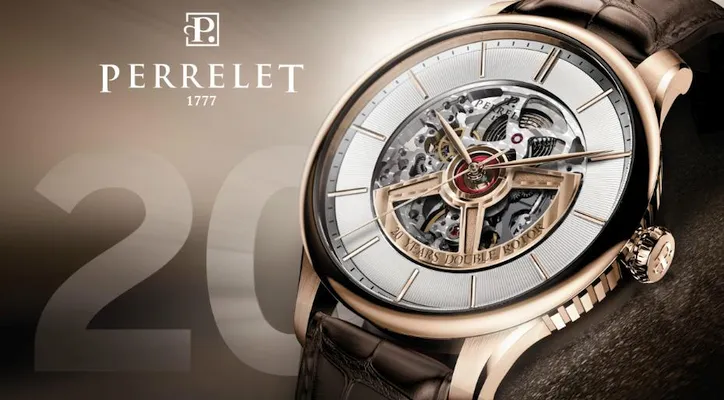
The self-winding Perrelet First Class Double Rotor Skeleton 20th Anniversary pays tribute to the Dipteros 1777 model that the brand issued back in 1995.
For Perrelet, the model was groundbreaking. It was the first among their watches ever to feature a so-called “double rotor” design where a front oscillating weight is visible freely right on the timekeeper’s face. Originally designed to advertise the fact that it was none other than Abraham-Louis Perrelet who first invented a self-winding timekeeper, the Dipteros 1777 became a grandfather of their current iconic Turbine family. The 20th Anniversary model was officially presented during the Baselworld 2015 show.
Overall Impression
Issued in a limited run of just 327 pieces (250 of them in more practical stainless steel and the rest in more attractive 18-karat rose gold), the Perrelet First Class Double Rotor Skeleton takes the idea behind the historic model and takes it to a new level.
The original Dipteros 1777 was a rather ordinary dressy timekeeper with the visible rotor being the only thing that differentiated it from hundreds of other models in the same niche. This new variety, however, lets you know quite explicitly that during the last two decades the brand evolved both in terms of build quality and industrial design.
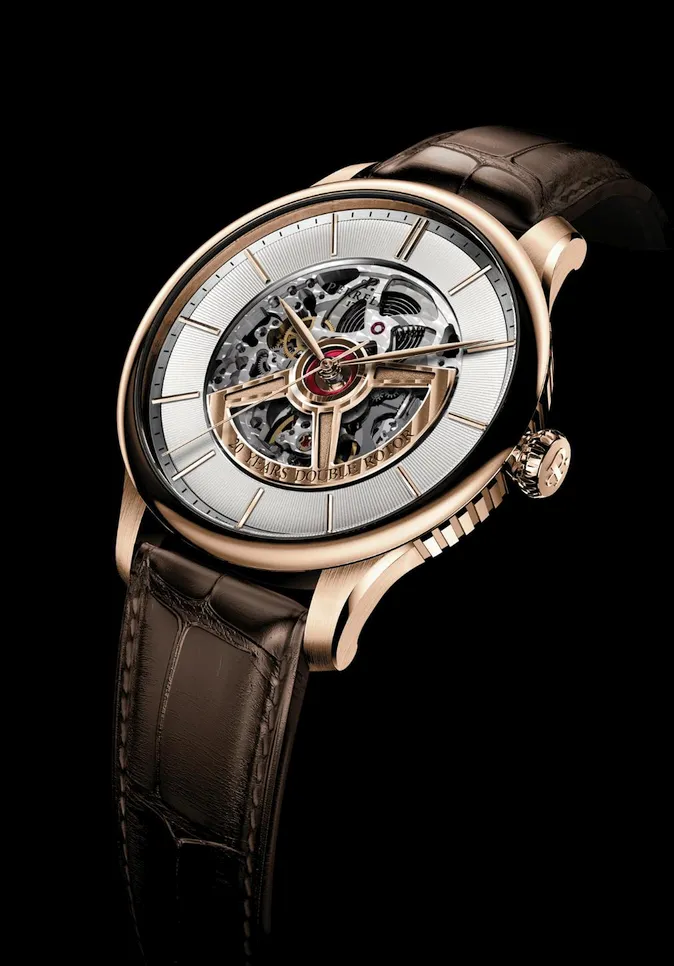
The 20th-anniversary version of the timekeeper successfully combines the classic idea of a skeletonized movement with a modern approach to design with flowing clean lines and extensive use of simple geometric figures.
If you will take a closer look at the pictures above and below, you will soon realize how much effort and thought was invested in the timekeeper’s finish. I especially like how mirror-polished surfaces on the gently oversized body are interspersed by machine-brushed areas (those thin brushed patches on the coin-edged side strip are a completely unexpected and therefore especially nice touch here).
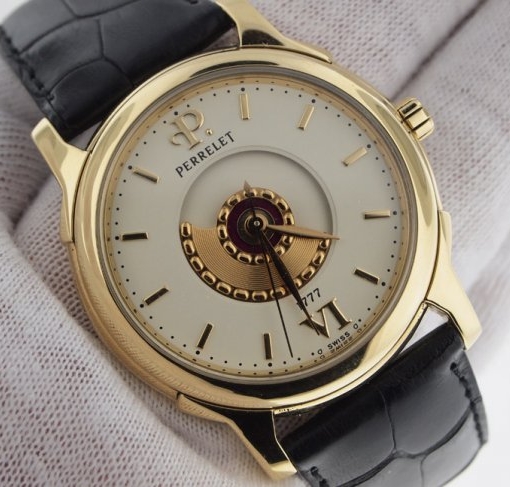
It is too bad that Perrelet failed to produce real photos of a production-ready model, but even on these 3D renderings, it is visible that the open-worked oscillating weight organically, and seamlessly blends into the frame set by the skeletonized baseplate of the mechanism. The fact that on the rose gold version the rotor iuses the same visually contrasting precious metal as opposed to something that looks like rhodium-plated steel or brass makes it look even more delicious.
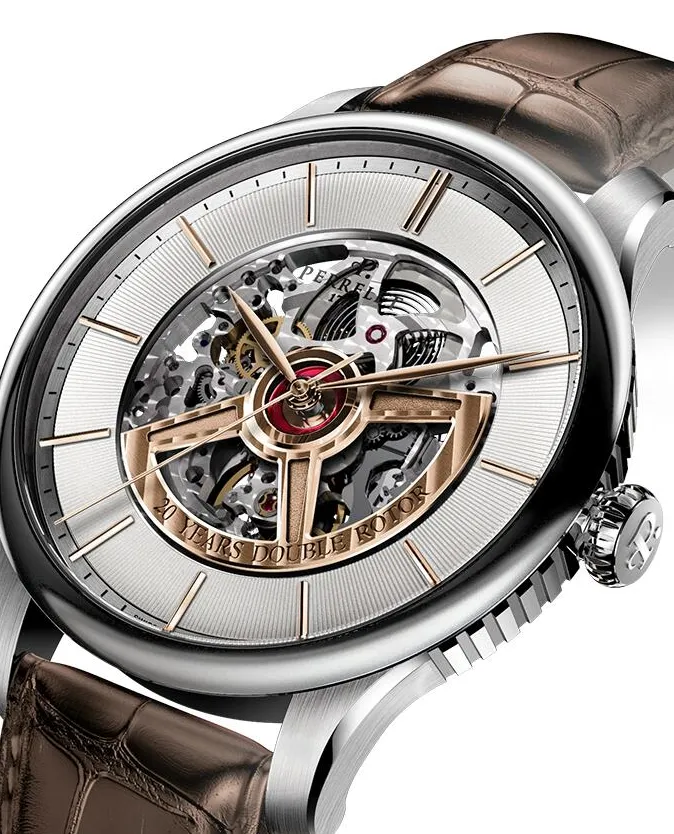
The traditional vertical Geneva Stripes on the rotor and the plate nicely match the same pattern on the movement. Something that looks like tremblage engraving on the relatively thin spokes gives the element additional visual depth and makes it look more massive: something that many major watchmaking brands overlook when they design their timekeepers.
Mechanism
The original Dipteros 1777 featured a Caliber P-181: a heavily modified version of the well-known ETA 2892A2. It featured redecorated bridges, was built using higher-end components and, of course, featured their patented co-axial Double Rotor system. The mechanism is still in production.
In fact, it still animates a number of their currently available Turbine models like, for example, this outrageous Perrelet Turbine Poker device. Yet, it was clear that an anniversary edition needs something more advanced and more readily available since ETA started gradually reducing its supply of mass-produced movements to third-party manufacturers.
This new variety comes as Caliber P-481 and, judging by its layout, is based on their earlier Caliber P-331 (they used the “engine” in the 2012 Special Edition XL Turbine Racing DLC model.) Perrelet refers to the P-481 as an “in-house” movement, but that, again, is an extensively modified Soprod A10 ebauche.
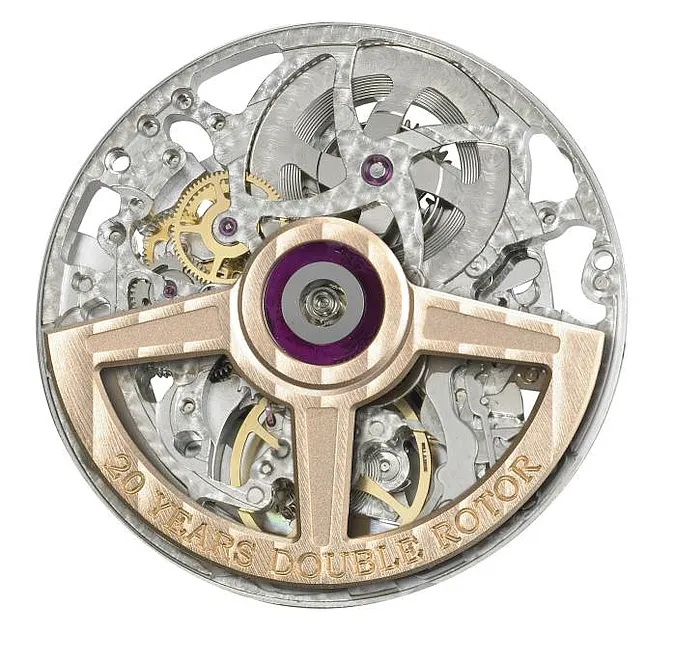
The fact that Perrelet prefers to market the mechanisms as “in-house” or “manufacture” ones looks a bit cheesy here: the mechanisms were definitely not developed from the ground up. Yet, the way they redecorate and fine-tune every single part of the blank movement and add their own elements built to higher probably specs gives them certain (at least formal) rights to call the mechanisms their own.
Case
As I have already noted, the watch comes in a mildly oversized body that is available in two versions: more formal stainless steel and dressier rose gold.
Measuring 42.5 millimeters in diameter, it is definitely more massive than an average watch, but not excessively so. Still, you must understand that, while the size is okay for something sportier -like a diver or a pilot,- which is in most instances is supposed to look massive and emanate self-assurance, this is a timepiece that is supposed to be worn with formal attire and, as flashy as it is, should not attract too much attention to your persona.
Taking into account how relatively long its lugs are, you should probably have wrists that are either wide or just massive to make enough room for this little beast.
Yes, it may be smaller than your average IWC Portugieser, but its “modern vintage” styling makes it look a bit awkward.
So, make sure to at least try one before ordering one of these things. I understand that this anniversary model does a good job of activating that impulse buying center in your brain, but, when it comes to watches this big, prudence is what you need.
See also: Refreshingly New: 2015 Chr.Ward C9 Jumping Hour MKIII
WWR verdict
Originality 5/5
Build quality: 5/5
Usability: 4.5/5
Legibility: 3.5/5
Value for money: 4/5
Photos: Perrelet
Perrelet First Class Double Rotor Skeleton 20th Anniversary specification
Price: From $8695 at Amazon.com
Movement: Automatic, Caliber P-481 (base Caliber P-331), Swiss Made
Number of jewels: 25
Movement frequency: 28,800 vph
Power reserve: 40 hours
Movement decoration: Skeletonized, Geneva Stripes, visible ruby in its center
Functions: Hours, minutes, seconds
Case: Stainless steel / 18-karat rose gold
Shape: Round
Size: 42.50 mm
Dial: Open-worked, white chapter ring
Hour markers: Rose gold, stick-shaped
Hands: Rose gold
Water resistance: 50 meters
Strap: Alligator leather strap with steel or rose gold buckle
Crystal: Sapphire, antireflective on both sides
Back: Sapphire
